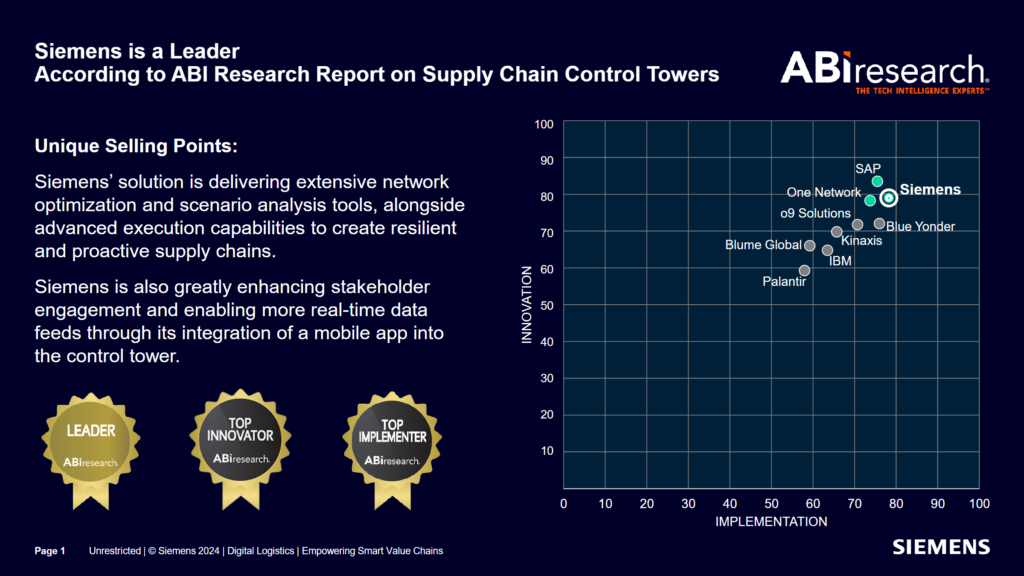CPG supply chains are overdue for a transformation—can yours keep up?

Legacy supply chains are a liability—why brands must act now
If recent years have proven anything, it’s that supply chains are more fragile than we ever imagined. One ingredient shortage, a regulatory shift, or a spike in demand can send ripples through an entire network—delaying production, increasing costs, and leaving companies scrambling to recover. The financial impact is massive; delays can cost millions in lost sales, while inefficiencies silently drain margins.
According to McKinsey, autonomous supply chain planning can increase revenue by up to 4%, reduce inventory by up to 20%, and lower supply chain costs by up to 10%. With stakes this high, companies that fail to adapt are leaving money on the table.
For consumer packaged goods (CPG) brand manufacturers, agility isn’t a luxury—it’s the difference between staying ahead and falling behind. Yet many companies still operate with long, inflexible supply chains designed for cost efficiency, rather than speed, visibility, or resilience. The challenge isn’t whether supply chains need to change—it’s how fast companies can adapt before disruption forces their hand.
Why traditional supply chains are breaking down—and what to do about it
It’s time to rethink supply chains as more than just cost centers. Agility, sustainability, and intelligent decision-making are now competitive advantages. The future of supply chains isn’t just about making small improvements—it’s about breaking free from outdated constraints and fundamentally rethinking how companies bring products to market.
Originally built for an era prioritizing stability and efficiency, CPG supply chains now face challenges requiring a more dynamic approach. Today, these systems are straining under the weight of demand volatility, supply shortages, and sustainability mandates. Manufacturers that don’t modernize will find themselves outpaced by more nimble competitors, unable to innovate fast enough, and facing frequent stockouts that drive customers toward rival brands.
Alternatively, when companies embrace the shift toward modernizing their supply chains, they unlock the ability to outmaneuver slower competitors, rapidly adapt to demand shifts, and accelerate innovation. By leveraging real-time data and integrated processes, manufacturers can avoid being disrupted by more agile market entrants, sustain long-term growth, and strengthen brand loyalty in an increasingly volatile landscape.
Ask yourself the following questions: if a supplier fails, can you pivot fast enough? If a regulation changes, can you reformulate without delay? If demand surges, can your production scale seamlessly? Without real-time visibility and integrated supply chain processes, most companies will answer no to those questions. Every delay has a cost: lost revenue, wasted resources, and consumers switching to another brand.
Turn supply chain complexity into opportunity with digital logistics
Supply chain disruptions are more than an inconvenience—they’re a major financial risk. Research shows that disruptions can cost an average organization 45% of its annual profits over a decade. With 94% of manufacturers expressing concerns about their supply chain’s resilience, digital transformation is no longer optional—it’s essential for survival.
We know that supply chains can become very complex. After all, CPG’s business is a global and complex affair. Eliminating complexity can only get you so far. Managing and embracing this complexity effectively is where competitive differentiation is created.
Looking at the logistics part of the supply chain, the right digital logistics approach turns this challenge into a competitive advantage. Digital logistics changes the game by integrating real-time data, predictive analytics, and AI-powered insights to streamline inventory, optimize transportation flows, and improve overall supply chain predictability.
By doing all this, manufacturers gain the ability to react to inevitable disruptions. But more importantly, it creates a path to move from putting out fires to predicting and anticipating production. This allows companies to proactively manage risks before they escalate.
But logistics alone won’t solve the problem—if your manufacturing strategy isn’t built for flexibility, you’re still at risk. Without the ability to adjust production dynamically, manufacturers remain vulnerable.
That’s why forward-thinking companies are shifting toward distributed production models, where multiple plants produce multiple products in strategic locations. Instead of a single point of failure, this approach enhances responsiveness to demand shifts, reduces transportation distances, and mitigates supply disruptions.
While other industries have already embraced flexible, multi-location production strategies, CPG is lagging. Those who modernize now will gain a lasting competitive edge.
Enterprise recipe management: The key to fast, flexible production
Supply chain flexibility isn’t just about logistics—it’s about what gets produced and how quickly formulations can change. One of the biggest obstacles in CPG supply chains is the inability to adjust product formulations when ingredients become unavailable or too expensive.
Enterprise Recipe Management (ERM) allows manufacturers to reformulate recipes on the fly, ensuring compliance while maintaining production efficiency. If an ingredient needs to be swapped, ERM ensures seamless integration into production—without costly delays.
For brands, this means fewer disruptions, less downtime, and better resilience against supply volatility. ERM helps accelerate product launches and changes by removing bottlenecks and enabling manufacturers to move faster.
Fixing intralogistics bottlenecks—keep production flowing smoothly
Securing materials is just the first step—getting them to the right place at the right time is where many supply chains break down. Intralogistics plays a critical role in keeping production moving by ensuring materials are where they need to be, exactly when they need to be there.
Many manufacturers still rely on outdated tracking systems and manual processes, which create bottlenecks and inefficiencies. By leveraging automation, AI-powered logistics, and traceability solutions, companies can gain real-time visibility into their materials flow, reducing downtime, optimizing inventory management, and ensuring raw materials are always available when needed.
Traceability and lifecycle intelligence—why visibility is non-negotiable
End-to-end visibility is no longer a nice-to-have—it’s essential for operational efficiency, regulatory compliance, and consumer trust. With traceability and lifecycle intelligence, companies can track materials from their source to the final product, ensuring quality, compliance, and sustainability.
With better visibility, manufacturers can quickly pinpoint inefficiencies, reduce waste, and ensure that every part of their supply chain is aligned with business objectives, while providing transparency to trading partners and consumers alike. Traceability also helps companies react quickly to recalls or compliance issues—minimizing financial risk and damage to the brand.
Cut CO₂ emissions while improving efficiency—yes, it’s possible
With 80% of a product’s environmental impact determined at the concept phase, digitalization across the product lifecycle is key to building a more sustainable supply chain. The global logistics industry contributes over 3 billion metric tons of CO₂ annually, making it one of the largest carbon emitters worldwide. But cutting emissions can’t come at the cost of efficiency. The challenge is finding ways to reduce carbon footprints while maintaining speed and cost-effectiveness.
Smarter logistics planning, route optimization, and digital supply chain solutions allow companies to reduce transportation miles, optimize production locations, and adapt their operations to meet sustainability goals—all without sacrificing profitability.
Companies that move first on sustainability will also gain a competitive edge with consumers, retailers, and investors.
How Siemens helps companies transform their supply chains
At Siemens, we help manufacturers embrace and manage complexity, increase supply chain flexibility, and optimize logistics. To demonstrate:
- One manufacturer improved end-to-end supply chain visibility, enabling them to predict and adapt to disruptions before they happened, , resulting in reduced downtime and increased operational efficiency.
- A brand manufacturer in Italy saw a 30% reduction in inventory by leveraging our advanced production scheduling solution, ensuring materials and ingredients flowed seamlessly.
- Companies focused on sustainability have successfully slashed their carbon footprints without losing efficiency, proving that it’s possible to overcome the typical 80% logistics-related CO2 emissions through optimized logistics strategies.
That’s why the world’s leading CPG companies don’t just trust Siemens—they rely on Siemens to future-proof their supply chains. ABI Research ranks Siemens at the top of its 2023 Supply Chain Competitive Ranking, proving our ability to help manufacturers move faster, work smarter, and stay ahead of disruption.

See it in action: How companies are already transforming their supply chains
Companies like BSH and Leder & Schuh have embraced digitalization to transform and streamline their supply chains. BSH improved its complex global supply network, enhancing logistics coordination, reducing operational inefficiencies, and cutting the time to run studies by 50 percent. Leder & Schuh optimized their supply chain by integrating processes across 500 suppliers and 300 retail sites, increasing container fill levels by over 15 percent, nearly eliminating less-than-container loads, and reducing transportation costs from Asia.
Optimize your supply chain—faster, smarter, and more sustainably
Every day of delayed transformation has real costs. Our supply chain assessment gives you:
- A detailed analysis of your current operational inefficiencies
- Potential cost savings across your entire supply network
- Specific recommendations for digital transformation priorities
- Clear ROI projections for recommended improvements
Ready to see the numbers? Let’s talk! Contact us for a complimentary, quick supply chain efficiency assessment—a streamlined analysis that pinpoints exactly where and how much value you could unlock in no time.


